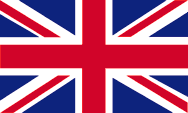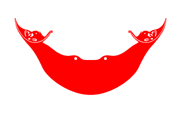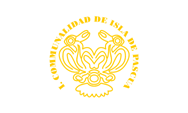mobile Ansicht, to the English Version tap the flag


- chilenische Provinz und Gemeinde im Pazifischen Ozean
- Eigenbezeichnungen:
– Spanisch: Isla de Pascua
– Rapanui: Rapa Nui
• Flaggen
• Bedeutung/Ursprung der Flagge
• Zahlen und Fakten
• Geschichte
• Ursprung des Landesnamens

offizielle Flagge der Provinz Osterinsel und Sala y Gomez,
Seitenverhältnis = 5:8,
Quelle, nach: Flags of the World




offizielle Flagge der Gemeinde Osterinsel,
Seitenverhältnis = 3:5,
Quelle, nach: Flags of the World




Die Flagge der Gemeinde der Osterinsel zeigt den legendären Vogel Manu Tangata, ein in der Geschichte der Insel bedeutsamer Kultgegenstand, in Gold auf einem weißen Flaggentuch. Ringsherum der Name der Gemeinde in Spanischer Sprache. Die Flagge der Provinz und inoffiziele Flage der Insel zeigt einen roten Rei Miro, einen traditionellen Halsschmuck der Insulaner, auf einem weißen Flaggentuch. Diese Flagge repräsentiert die Ureinwohner Insel.
Quelle:
Flags of the World

Fläche: 163 km²
Einwohner: 7.750 (2017), davon 60% Rapanui, 39% Europäer
Bevölkerungsdichte: 48 Ew./km²
Hauptort: Hanga Roa, 3.304 Ew. (2002)
Amtssprache: Spanisch
sonstige Sprachen: Rapanui
Währung: chilenische Währung
Zeitzone: MEZ – 7 h
Quelle:
Wikipedia (DE)

5./6. Jahrhundert · Besiedelung der Insel durch Polynesier
14. Jahrhundert · weitere Besiedelung der Insel durch Polynesier
05.04.1722 · der niederländische Seefahrer Jakob Roggeveen entdeckt die Insel am Ostersonntag
15.11.1770 · Inbesitznahme durch Spanien
13./17.03.1774 · der britische Seefahrer James Cook besucht die Insel
1786 · der französische Seefahrer Jean-François de La Pérouse besucht die Insel
1859–1861 · Sklavenjagd durch Peruanische Seefahrer, Einschleppung von Krankheiten, Dezimierung der Bevölkerung
1866–1876 · Herrschaft des Franzosen Dutroux-Bornier, Dezimierung der Bevölkerung
09.09.1888 · Inbesitznahme durch Chile
1914 · Aufstand der Insulaner
1914–1967 · Kriegsrecht
Quelle:
Wikipedia (D), World Statesmen

Die "Osterinsel" verdankt ihren Namen ihrer Entdeckung am Ostersonntag, dem 05.04.1722, durch den niederländischen Seefahrer Jakob Roggeveen.
Quelle: Volker Preuß


![]()







